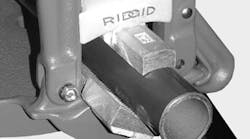Although engineers and electrical designers recognize the performance advantages of using PVC-coated conduit in corrosive environments, making sure field installers understand and adhere to accepted installation practices continues to be a challenge. But it doesn't have to be this way. All it takes to realize a successful installation is to follow a few simple precautions, use the right tools, adhere to manufacturer-specific recommendations, and protect the coating at every stage of the installation. In fact, PVC-coated conduit installation procedures are pretty much the same as those used to install standard galvanized conduit, with a few minor exceptions.
Materials and tools
There are three basic types of PVC-coated conduit: primary PVC coating over bare steel, PVC coating over listed galvanized steel conduit, and primary PVC coating over a supplementary coating of zinc. These PVC-coated raceways are generally installed as a system, which means the fittings, conduit bodies, straps, hangers, and boxes are also coated. There are, however, installations where only a coated elbow is used in a galvanized conduit run, such as when it is emerging from the soil or concrete.
To minimize installation damage to the PVC coatings, you must use tools specially designed for PVC-coated conduit or rely on standard tools that have been appropriately modified for installing such material. Standard tools that have not been modified will most likely damage the coating and reduce its effectiveness in combating the effects of corrosion.
An effective approach in reviewing the accepted installation practices associated with this product line is to review each step of the process in detail. We'll start with a discussion on clamping and finish with assembly and installation.
Clamping
Various manufacturers offer modified jaws for use in standard vises to protect the coating while it's held in place for cutting and threading operations (Fig. 1). When using a jaw or chain type vise, you can also use half-shell clamps to protect the PVC-coated conduit. These are available as a manufactured product, or you can make your own set in the field from rigid metal conduit (RMC).
To make your own half-shell clamps, follow these simple guidelines. First, cut two 6-inch pieces of standard RMC one trade size larger than the PVC-coated conduit to be clamped. Next, use a band saw to cut the 6-inch conduit sections lengthwise. Make the cut slightly off center. This creates two half shells — one smaller than the other. Then discard the larger pieces and deburr any sharp edges. Properly made clamping sleeves will have a gap between the two pieces when positioned on the PVC-coated conduit (Fig. 2).
As a last resort, if you don't have access to a manufactured set of clamps and proper tooling isn't available to make your own set, then wrap the area of the conduit to be clamped with sandpaper, emery cloth, or cardboard. The coarse side of the emery cloth or sandpaper should face the PVC coating. Note: This is the least desirable method and should be avoided if possible.
Cutting and threading
It's preferable to cut PVC-coated conduit with a saw rather than a roller cutter. However, a roller cutter can provide an acceptable cut as long as you properly clamp the conduit in place before you proceed.
If PVC-coated conduit is cut with a hacksaw or a band saw, and you elect to use a hand threader to thread the conduit, then make sure and trim the coating at an angle all the way around the conduit before you begin the threading process. This is sometimes referred to as making a pencil or bevel cut. What this does is allow for the die teeth on the threader to engage the conduit properly (Fig. 3). Be sure the conduit is securely held in the vise before beginning this process.
You must modify a standard die head (i.e. machine it) for use on PVC-coated conduit. To make this modification, bore the guide sleeve to allow the coated conduit to easily enter the die. You must increase the inside diameter by 110 mils (0.11 inch). Do not remove the PVC coating to allow for the use of standard non-machined die heads.
Do not use rotating machines with jaws as they can cut through the PVC coating. Long strips of metal or PVC from the threading can foul the die head and collapse the conduit. To avoid this and permit removal of PVC in small pieces, make a series of longitudinal cuts in the PVC coating (along the conduit) in the area to be threaded. You can use the thread protector as a length guide for the cuts (Fig. 4). Following the cutting operation, use a reamer to remove any rough edges (Fig. 5).
After threading and reaming the conduit, clean the threads and conduit interior with a degreasing spray to prepare for the application of the touchup compound. Cleaning will ensure good adherence of the compound to the unprotected substrate.
The requirements of 300.6 of the 2005 NEC state that where corrosion protection is necessary and the conduit is threaded in the field, the thread shall be coated with an approved electrically conductive, corrosion-resistant compound (Fig. 6). Coatings for this purpose are listed under UL category “FOIZ.” You may also use zinc-rich paint or other coatings acceptable to the Authority Having Jurisdiction (AHJ). Corrosion protection is provided on factory-cut threads at time of manufacturing.
Bending
Manufactured elbows are available in a variety of radii; however, the need for field-bending conduit is inevitable. To hand bend small diameter PVC-coated conduit, use an EMT bender one trade size larger than the conduit being bent. This will help you avoid damaging the coating. For example, to bend trade size 3/4 PVC-coated conduit, use a trade size 1 EMT bender.
The use of a bender with shoes made specifically to bend PVC-coated conduit is preferred. Otherwise, for trade sizes 1/2 through 1 1/2, use an electric-powered bender (Fig. 7) with EMT shoes one size larger than the conduit. When working with trade sizes 2 and larger, use a hydraulic bender. Never use lubricants in the shoes or on the conduit. Lubricant allows the conduit to slip above the centerline of the shoe, resulting in a flat elbow.
Most manufacturers of hydraulic benders offer special shoes for bending PVC-coated conduit. Use these special shoes when possible. If regular shoes are used, their sides must be modified to allow for the coating thickness. Some installers have accomplished this by grinding or milling down the inside of the shoe. This type of modification is not recommended, as it can create a safety hazard for the equipment operator.
Assembly and installation
Do not use ordinary slip-joint pliers or standard pipe wrenches on PVC-coated conduit because they'll damage the coating. Use specially designed pliers or wrenches with fine teeth. You can also use strap wrenches to tighten conduit or couplings without damaging the coating. Slip-joint pliers of the Channel-Lock™ type, specially equipped with wide jaws, are also good at protecting the coating.
Note that for PVC-coated conduit, wrench sizes are the same. However, the jaw of the wrench must be specially designed for PVC-coated conduit. If that's not available, use a strap wrench. Since the threads of PVC-coated conduit are not visible, because PVC sleeves cover them, take extra care to be sure they're fully engaged and made up wrench-tight.
Sleeves on PVC-coated conduit couplings and fittings are provided to ensure continuous coating protection. Protection is added because the coating is separate, not continuous, between a section of conduit and fitting. This provides protection and makes the coating more resistant to corrosion penetration. To make the sleeve softer in cold weather applications, soak the coupling or fitting in warm water. To make installation easier, you can apply silicon sprays to the inside diameter of the sleeve. Do not use threadless fittings with PVC-coated RMC or intermediate metal conduit (IMC).
Even when following recommended installation practices, the PVC coating will sometimes get damaged during installation. This destroys the coating protection and provides for entry of corrosive elements. Patch the damaged areas as per the raceway manufacturers' instructions.
If using expansion joints in PVC-coated conduit systems, it's recommended that you install an external bonding jumper. Generally, this will require you to remove a portion of the PVC coating from the conduit where the jumper will be attached. Once you install the jumper, you must then repair the surrounding coating with touch-up compound provided by the manufacturer. Follow the manufacturer's instructions for proper installation.
Several PVC-coated conduit manufacturers now offer formal installer certification for contractors who install coated conduit systems. Because manufacturers recognize the importance of a proper installation, many offer this training at no cost. Attending such a session will help prepare you deliver provide the best installation possible.
Editor's note: The guidelines and photos presented in this article were adapted from source material provided by the Steel Tube Institute of North America (www.steelconduit.org).



